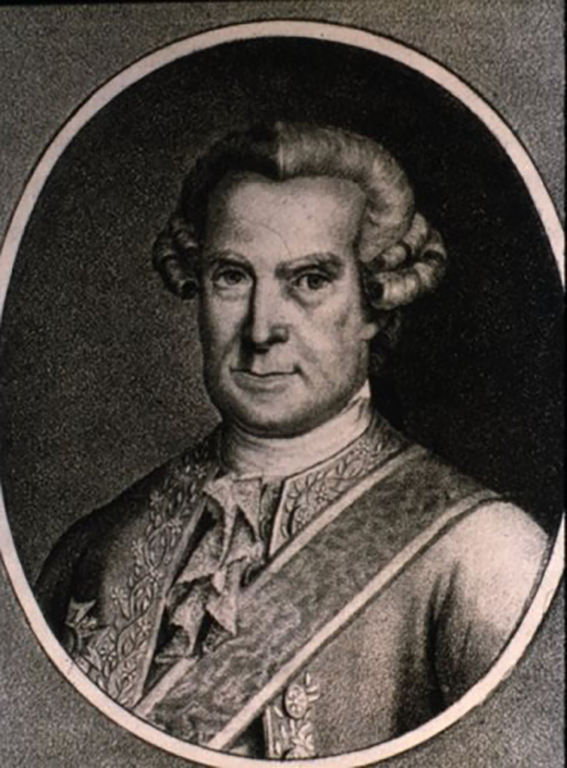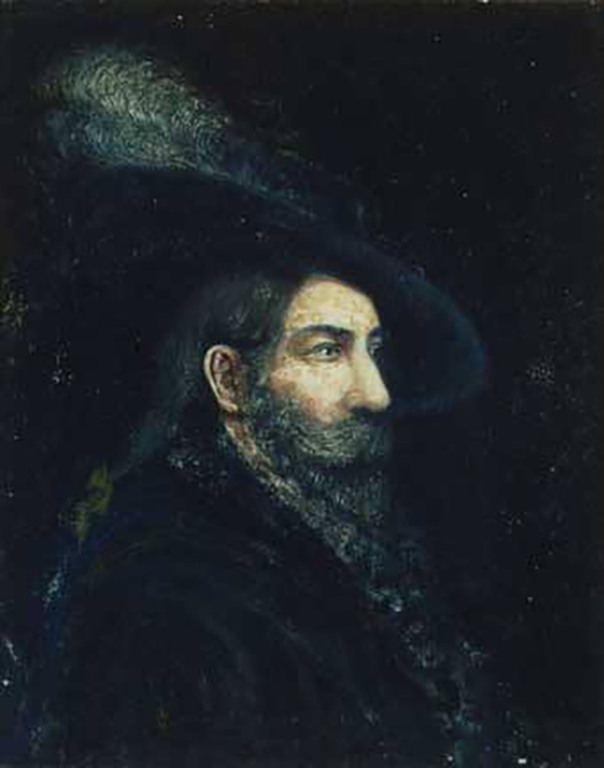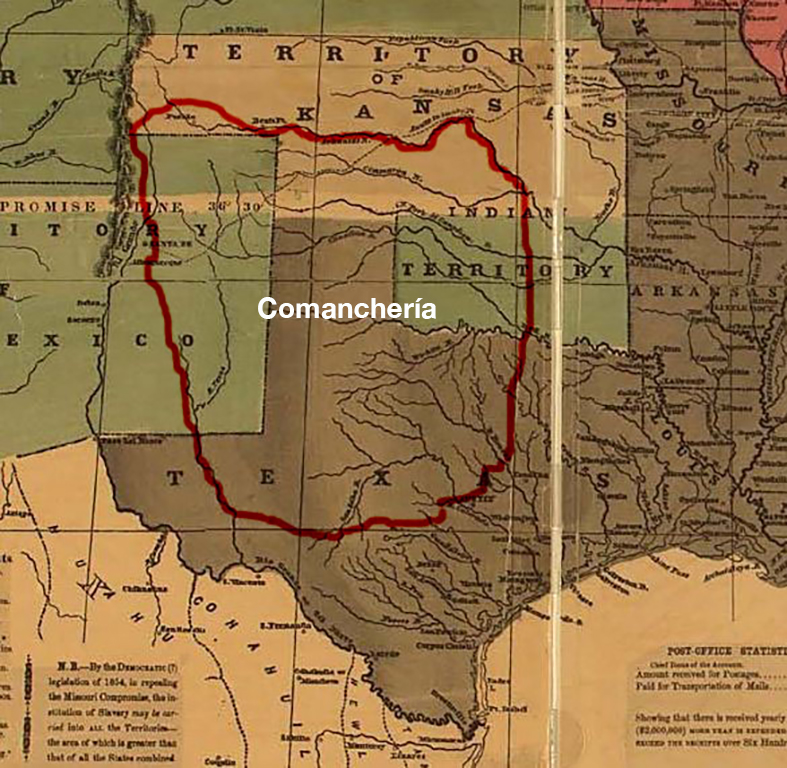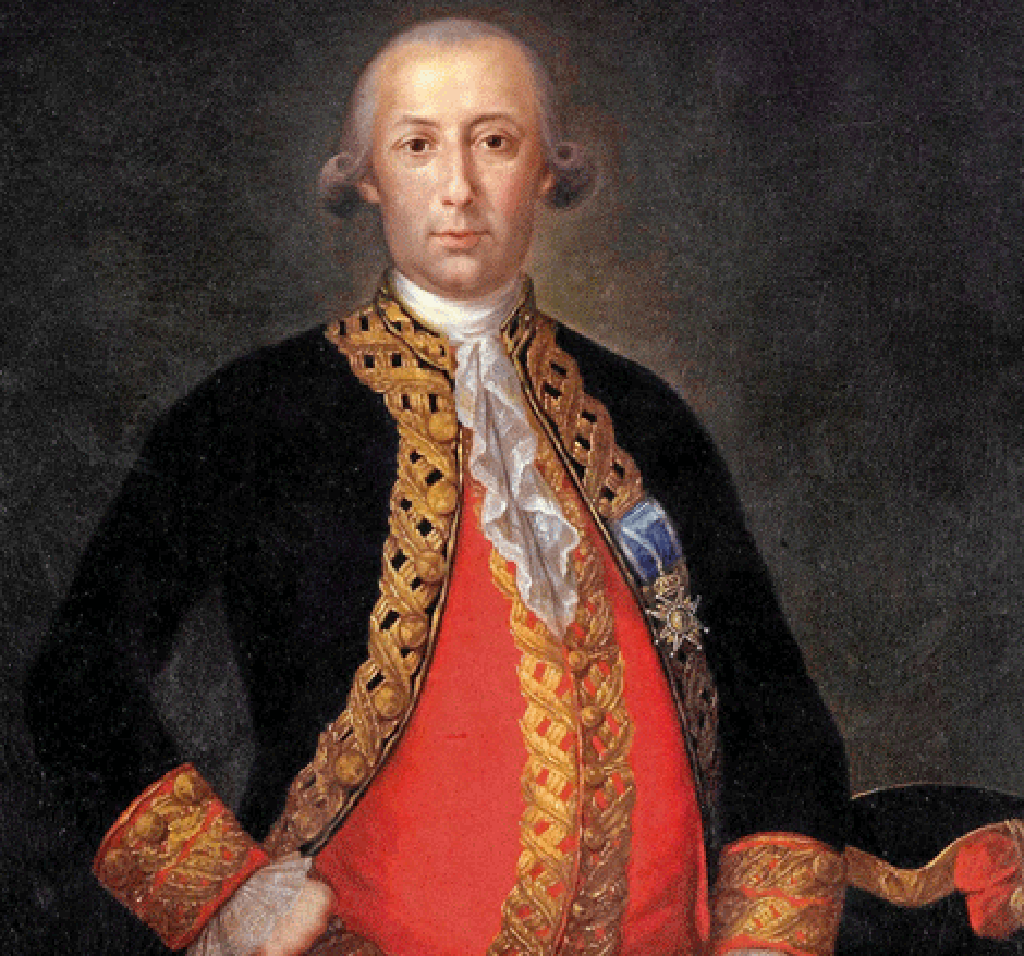The History of New Mexico
Collapse
Expand
-
Chapter 6: New Mexico & The Battle for North America
- New Mexico & The Battle for North America
- Imperial Competition in North America
- Bourbon Reforms & New Mexico
- Late Colonial Age
- References & Further Reading
As the Segesser Hide Paintings illustrate, New Mexico’s colonial history was characterized by isolation, the constant threat of raids, and contests with other European colonists. One lifelong scholar of New Mexico history has asserted that the colonial period was a time of general misery.5 Indeed, governors, Catholic priests, and colonists alike often reported miserable conditions in their communications with people beyond the colony. Yet to characterize the colony as a place of sustained misery is misleading. Nuevomexicanos often characterized their experience in such terms to bolster petitions for reinforcements, new supplies, and other types of aid. As indicated by the case of the trade in French goods, they took the initiative to carve out the best situation possible.
By the late eighteenth century, King Carlos III of the Bourbon royal family recognized that his far-flung empire was in dire need of structural reforms if it was to once again be a political and economic powerhouse. The Spanish Empire was in a state of decline for a number of reasons. Spain’s empire was the most far-reaching in history; the maintenance of lines of authority, communication, and shipping proved problematic. The wealth of the silver mines in Zacatecas and Potosí, Bolivia, promised an era of prosperity and dominance. Spanish kings’ affinity for religious war, combined with pirates in the Atlantic, meant that the advantage presented by the silver deposits was ephemeral. The older system of overlapping jurisdictions, designed by Spain’s first kings to ensure officials’ personal loyalty, was cumbersome and inefficient.
Carlos III initiated a series of new legislation, known collectively as the Bourbon Reforms, which applied insights of the European Enlightenment to the empire’s problems. The three main goals of the reforms were to “streamline public administration, raise productivity and trade, and increase security in the Americas.”6 The first target was the bloated administrative system of the Spanish Americas, which included an excessive number of governorships and regional posts that sapped imperial resources. Many of these positions had been purchased. The other two goals of the reforms had specific implications for New Mexico. In order to turn a profit in the Americas, the king wished to create conditions that opened new trade opportunities with native peoples. In this instance, the Crown simply accepted the reality of trade between Spanish subjects and indigenous peoples in peripheral areas, including New Mexico and the La Plata region of South America. Additionally, officials close to the king hoped to reverse the status quo in order to trade with Comanches on Spanish terms.
Bourbon Reforms came in the aftermath of the French and Indian War (which extended to become the Seven Years’ War in Europe), which redrew the map of European empire in North America. The conflict itself centered on competing French, British, and indigenous claims to the Ohio River Valley. When the dust settled in 1763, the British and their native allies achieved a decisive victory. Spain joined the effort in support of the French near the end of the war, and found itself on the losing end of the conflict. Although the reasons remain unclear, France ceded Louisiana west of the Mississippi River to Spain through the secret Treaty of Fontainebleau in November 1762. Louisiana was a financial liability for France. The gesture may also have been an attempt to compensate Spain for losses it had incurred as a French ally during the conflict.
The February 1763 Treaty of Paris officially ended the war. England recognized Spain’s right to western Louisiana, but took the eastern portion of the colony, all of New France, and Florida. England emerged as Spain’s only European rival in North America, a situation of grave concern to Carlos III who had only reluctantly accepted economically unstable Louisiana. Despite the potential for fiscal drain, he recognized the necessity of holding as much territory as possible as a buffer against English colonists who looked covetously toward the west.
Given such momentous changes, Carlos III resolved to address issues of security and stability along New Spain’s northern frontier. To that end, he dispatched the Marqués de Rubí to make a reconnaissance of the area’s defenses and populations. The king needed a clearer picture of the realities faced in each of the northern provinces, especially those at the edge—Texas and New Mexico. Between 1766 and 1768, Rubí traversed over 7,500 miles as he surveyed the various settlements in the north. In his various reports he detailed the barriers to communication and transportation between New Mexico and Texas. Despite their geographic proximity, Comanches and others dominated the spaces in between their corridors of settlement, forcing travelers to hold to the Camino Real rather than attempt to move more directly between the northern colonies.

Courtesy of PhilFree
Other royal officials, such as José de Gálvez, also toured the north in order to assess the situation there. Both men supported Carlos III’s efforts to curtail the political and economic power of the Catholic Church. Based on recommendations from a number of royal administrators, and in order to reinforce the power of the state over the Church, all members of the Jesuit order were expelled from the Spanish Empire in 1767. Major administrative decisions hung on the recommendations of the Bourbon king’s advisors. Gálvez’s and Rubí’s reports provided the king with a much clearer understanding of the situation in the north, but royal administrators still lacked local knowledge. Issues such as language barriers and alliances that had been formed through intermarriage and gift giving still eluded his view.
Most directly, the Reglamento de 1772 (Regulation of 1772) was issued as a result of the work of Rubí and Gálvez. The Reglamento was a set of legislation that applied Enlightenment reasoning to the problems faced in the northern frontier. Rubí reached the overall conclusion that New Mexico’s development was hindered by the hostility of native peoples. Santa Fe boasted the only presidio north of El Paso, and it was not a very strong garrison. The nuevomexicano population was ill-prepared for war with local natives, let alone the British (if it ever came to that). Poverty and stifling trade restrictions exacerbated the problem; many nuevomexicanos were armed with only bows and arrows, while Comanches carried guns. To the south in Nueva Vizcaya, Rubí found that many settlers had simply abandoned their towns wholesale in the face of conflicts with natives. Despite the persistent unwillingness to recognize their power, Comanches were expanding their own empire at the expense of New Spain.
The Reglamento de 1772 offered solutions to these issues. More money was budgeted for military defense. Soldiers received uniforms and regular pay due to increased military spending and measures to curb corruption. Significantly, uniforms and regular pay went a long way in promoting professionalism and loyalty among the troops. Additionally, the Reglamento called for a “rational line” of presidios along the 30th parallel, to the south of the present-day U.S.-Mexico border. The result was a series of fifteen presidios, spaced one hundred miles apart, between Altar, Sonora, and La Bahía, Texas. Far to the north of the rational line, Santa Fe and San Antonio, the capitals of their respective provinces, were considered a “separate frontier.”7 Although the Reglamento was a vast improvement to frontier security, it was also shortsighted. The line that appeared so rational on maps was laughable to Apaches and Comanches who continued to traverse the spaces in between the presidios.
To supplement and enhance the Reglamento, in 1776 the northern section of New Spain was reorganized into a separate administrative jurisdiction called la Comandancia general de las provincias internas (Internal Provinces). A comandante general who held authority independent of the viceroy was to preside over the Internal Provinces. Yet the new Internal Provinces remained within the viceroyalty of New Spain, making the jurisdiction only semiautonomous. Teodoro de Croix was appointed as the first comandante general, a post he held until 1783. As he set about to apply and enforce the Reglamento, he quickly realized that its stipulations did not match local realities. To rectify the situation, he created a contingent of light troops, the tropas ligeras, trained to move rapidly with fewer horses. Additionally, he organized flying companies, or compañías volantes, which were trained cavalry units. Together, these new military forces worked to fill in the gaps along the line.
New Mexico and Texas, however, remained far north of the rational line of protection. Among the various conversations of Bourbon officials regarding the northern frontier, the notion that the borders be pulled back if necessary had gained some credence. In order to shore up settlements beyond the line, Croix pushed governors of the Internal Provinces to forge alliances with native peoples. Governor Juan Bautista de Anza arrived in Santa Fe with the specific assignment to build an alliance with the Comanches—a seemingly impossible task. José de Gálvez had said as much during his tour of the northern frontier. Croix, however, believed that the continued existence of New Mexico depended on it.

Fray Orci (painter). Courtesy of Palace of the Governors Photo Archives (NMHM/DCA), No. 050828.
Governor Anza’s life and outlook had been shaped by his experiences in the north. He had been born in Sonora in 1736, and his father was a presidio captain. His own career was initiated through service in a frontier presidio army, where he built a reputation as an able leader, explorer, and fighter. Eventually, he became commander of the several presidios throughout Sonora. Anza blazed new roads to connect Sonora with Alta California which was a new target of Spanish colonization from the 1740s through the end of the colonial period. Having laid out the sites for the future villa’s presidio and mission, Anza is credited with the founding of San Francisco in 1776.
Despite the level of frontier experience that the new governor brought to New Mexico, forging peace with Comanches would be no small task. The Numunu (or “the people”), as the Comanches called themselves, first appeared in Spanish records in 1706. Known for their dominance of the Comanchería, as their homeland on the Southern Plains came to be known, they were relative newcomers to the region. Much like the histories of the Spanish and the French, theirs was a story of colonization, conquest, and empire building. Only recently historian Pekka Hämäläinen has offered this reevaluation of Comanche dominance of the northern frontier. As he convincingly illustrates, Comanches practiced a type of imperialism that forced all inhabitants of the northern frontier, whether European, mestizo, or indigenous, to recognize their prowess. And, as Hämäläinen reminds us, “The Comanche empire was powered by violence, but, like most viable empires, it was first and foremost an economic construction.”8
Tradition holds that the Numunu migrated southward from the central Great Plains at the turn of the eighteenth century. Theirs was part of a series of native migrations in North America during the late 1600s and early 1700s that came in response to the expansion of the French fur trade, British and French conflicts, and the expansion of European territorial claims. Native peoples moved in search of new fur trapping opportunities due to the depletion of beaver populations in the northeastern sector of the continent. They also relocated in order to preserve their cultures and identities in the face of European colonialism.
Comanches followed this pattern into the southern llano estacado, where they reinvented themselves as a formidable political and economic challenge in a geographic area that had long been a meeting place of cultures. Originally descendants of Shoshone bands, upon their arrival on the northeast fringes of the New Mexico colony they relied on new connections with Ute and Apache peoples to stake a claim to the area. Utes, for example, first introduced them to the trade fairs at Taos and Pecos. Yet they quickly moved to dominate the peoples that had helped them to gain a foothold at the trade fairs. Ute and Apache peoples migrated toward the west and southwest in order to escape their dominance. The Apache informants who spurred the Villasur expedition had fled to Santa Fe to escape Comanche attacks. By 1726, nuevomexicano Brigadier Pedro de Rivera characterized the Comanches as a brutal, nomadic people, traders in captives who “make war on all nations” and “travel in battle formation” at all times.9
Conventional reports trace the origin of the term “Comanche” to Spanish corruptions of a Ute word, kumantsi, which has been translated as “enemy.” Although we know that Comanches and Utes initiated close relations as soon as the Numunu arrived in the region, this single word is our only clue about the nature of those early encounters. If the term is translated to mean enemy, the inference is that the first contact was based on violence or intimidation. More recent linguistic interpretations, however, suggest that kumantsi refers to “a people who were considered related yet different.” This reevaluation pushes us toward a new understanding of the initial encounter as “a reunion of two Numic-speaking peoples, who…despite centuries of physical separation, found a unifying bond in their persisting linguistic and cultural commonalities.”10
Adoption of the horse allowed the Comanches to create a unique culture and society that was born in the llano estacado in the early decades of the eighteenth century. Horses were not simply tools used to enhance travel, hunting, or warfare; they became central to Comanche identity. Through their mastery of the horse, they expanded their hunting grounds, contact with other peoples (including French and Spanish colonists), and trade capabilities. They constructed trading circuits that allowed them to gain French firearms and manufactured goods along the eastern flank of the Comanchería in exchange for bison hides and meat. They then traded those items at New Mexico’s exchange fairs as well. As their prowess with the horse and their economic savvy increased, they claimed more territory to hunt buffalo.

Courtesy of Left Hook and Library of Congress
Along the eastern fringes of New Mexico, Comanches had displaced Jicarilla Apache bands by the 1720s as they expanded their empire. Apaches, although great horsemen, did not match Comanche prowess on horseback. As the Numunu pushed the Jicarillas to migrate, they inserted themselves into existing Apache trade networks. By the 1720s, then, Comanche presence at Taos and Pecos became an annual occurrence. At first, nuevomexicanos resisted trade with Comanches because they were unsure of their intentions. Comanche raids on eastern Pueblo and nuevomexicano settlements, coupled with the sheer lack of manufactured goods in the colony, caused them to quickly change their attitude. In this case, as in many others over the course of the colonial period, raiding was clearly utilized as a tool to create the desired economic outcome. Nuevomexicano officials began to see Comanches as an important barrier between themselves and the French by midcentury.
Even as trade ties increased, however, tensions remained. Interestingly, Texas colonists maintained their attitude of defiance toward the Comanches and refused to open trade relationships. As a result, Comanche raids on Texas settlements continued with regular frequency, and at times Texan goods that had been secured during raids were traded to nuevomexicanos at Taos or Pecos. Conflicts with New Mexican settlements also persisted at times despite the trade. As indicated at the opening of this chapter, captives taken during raids often perpetuated cycles of retributive violence that were at once destructive and economically beneficial. Nuevomexicanos chafed at Comanche dominance of trade, communication, and transportation. By the 1760s, for example, Comanches sold more horses and manufactured goods to nuevomexicanos than nuevomexicanos sold to them.
Comanches were successful in building a powerful, nomadic empire because they were adept hunters, traders, and diplomats. Also of great importance was their ability to absorb other peoples, including Apaches, Utes, Pawnees, Pueblos, and, at times, people of European descent. Many of these people began their lives among the Comanches as captives or runaways hoping to escape retribution in their own societies. Over time, even captives were offered opportunities to marry into Comanche clan and kinship networks if they so desired. This is not to say that Comanche forms of slavery were somehow benign, but it is important to recognize that captivity was not necessarily a permanent status among the Numunu. The overall Comanche population grew from about 15,000 in 1750 to over 45,000 in 1780 through such dynamics.
Governor Juan Bautista de Anza fully recognized the immensity of the task that Croix had assigned to him. As soon as he took up his post in Santa Fe, he began to construct a plan and to outfit a military force. Anza understood that Croix’s hope was that Comanches would become dependent on the Spanish Empire economically when an alliance was forged. Such hope may have been a bit shortsighted due to Comanche dominance of trade flows to New Mexico, but the use of the prospect of trade rather than conversion to Catholicism to bind indigenous peoples to Spain was a novel one. And, Anza, Croix, and their superiors in Mexico City and Madrid all hoped that such alliances would form quickly enough to preempt possible alliances with the British who controlled all of North America east of the Mississippi River.
In late 1778, Anza gathered five hundred nuevomexicano recruits and two hundred Pueblo allies at San Juan Pueblo (Ohkay Owingeh) where they were supplied with new weapons and fresh horses. They set out toward the north, looking for Comanche bands. Along the way, they encountered some Ute warriors that they convinced to join their contingent. Anza’s plan was to strike a major offensive against the Comanches that would force them to come to the negotiating table. His plan was risky because a decisive military strike might also result in the destruction of his own forces, or, if successful, in new cycles of retributive violence against New Mexico.
The force travelled by night in order to preserve the element of surprise. They crossed the Rocky Mountains at Pike’s Peak and moved eastward onto the plains where they located a Comanche encampment (near present day Pueblo, Colorado). Apparently undetected, Anza ordered a hasty attack in order to press their advantage. In the ensuing skirmish, a few Comanches were killed and the rest taken captive. The nuevomexicanos quickly realized that no warriors were present at the encampment. This type of victory was not what Anza sought.

Courtesy of Beverly Lussier
As Anza’s forces prepared to move out with captives in tow, the governor received word that Comanche headman Cuerno Verde (Green Horn; Tabivo Naritgant was his native name) had just led an attack against Taos. Anza pressed his men southward as rapidly as possible in an effort to head off the Comanche war party. Cuerno Verde’s force had been repulsed by the garrison at Taos, and as they made their retreat they encountered Anza’s contingent near present-day Green Mountain, Colorado. The nuevomexicanos trapped the Comanches, and in the ensuing battle Cuerno Verde and twenty warriors were killed. Anza sent Cuerno Verde’s headdress to Croix as evidence of his success.
Although Anza had achieved the type of strike that he had hoped for—he certainly got the Comanches’ attention—it remained to be seen how the Numunu would react. Fortunately for Anza, events played out much as he had imagined. In the fall of 1779 peace negotiations began with Ecueracapa, another of the most prominent Comanche headmen. A treaty emerged that both sides viewed as a success. Comanches correctly believed that they had not ceded any of their power by becoming allies of the Spanish. As a result of the alliance, they were able to exchange for even more trade goods with nuevomexicanos, including guns, leather goods, knives, and other manufactured products that reached New Mexico via Chihuahua merchants. Governor Anza’s actions solidified New Mexico’s position far to the north of the rational line of presidios, and Comanches promised to be a powerful ally against continuing Apache raids.
In 1786, two years before the governor’s death, Navajos and Utes were added to the negotiated peace. The result was an unprecedented system of exchange and cooperation that created long-term tranquility in New Mexico. Because peace arrangements were based on gift exchanges subsidized by the Spanish Crown, however, Mexican independence in 1821 signaled the beginning-of-the-end for the time of peace. Mexican officials, occupied with a plethora of political intrigues and economic concerns, refused further subsidies to support the negotiated arrangements. Yet thirty-five years of peace at the end of the Spanish colonial period allowed for the blossoming of a unique nuevomexicano culture and society.

Courtesy of Wikimedia Commons
The only people who remained outside of the treaties were Apaches. Hard on the heels of Governor Anza’s peace settlement with Comanche, Navajo, and Ute peoples, Bernardo de Gálvez (nephew of José de Gálvez and successor to Croix as comandante general) initiated a system of establecimientos de paz (peace establishments) alongside borderland presidios in an effort to pacify Apache groups. Officials believed that the time was ripe for solidifying peace with Apaches as well. In early 1786 Apache-Spanish raiding and violence had diminished, although small engagements continued infrequently.
To entice them to settle at the new peace establishments, Apaches “received food, liberal quantities of liquor, and weak-barreled rifles, which frequently misfired and required constant Spanish-provided maintenance.”11 The idea was to create a situation of dependency that would force Apaches to adopt “civilized” Spanish lifestyles. Gálvez made this point explicit by arguing that the establishments and the trade terms he wished to produce were intended to create a system of supervised bartering between indigenous peoples and Spanish settlers. Specifically, he hoped to promote Spanish supremacy in terms of access to horses, rifles, and ammunition. He argued that the Natives receive weapons with extra-long barrels to limit their ease of use—especially on horseback.
Much to Gálvez’s dismay, Apaches either avoided the peace establishments or adapted them to their own purposes. On March 21, 1787, Chihenne Apache headman Ojos Colorados fled one such establishment at San Buenaventura (near Casas Grandes) with seven other Mimbreño (as the Spanish then referred to the Chihene) chiefs and somewhere between eight hundred to nine hundred people. As they fled, they killed several Spaniards and three Chiricaguis and they took one other Chiricagui captive. From the Spanish perspective, this incident was a prime example of Apache treachery. Officials ordered a few hundred troops into the field to counter the terror inspired by Ojos Colorados and his people. The two-year campaign fed the population of the military colonies in northwestern Chihuahua as Spanish men proved their valor and were rewarded with land and status through war against Apaches. Then, just as abruptly as they had fled, Ojos Colorados led his people to seek peace at the Janos presidio in late 1789. Such actions indicated that his Chihenne band treated “Janos as a headquarters and not a prison.”12 In following this pattern of fleeing and returning to sue for peace at advantageous moments, Apaches maintained their independence as well as trade ties with the Spanish. Thus, the situation of peace proved to be ephemeral in the raid-and-trade economy of the colonial borderlands.
Even with such troubles, Gálvez’s policies were successful in that they forged different types of relations with native peoples in the northern frontier. By accepting the well-established cycles of raiding and trading as the reality of northern New Spain, officials found new ways to navigate them. Gálvez’s motto was “A bad peace…would be more fruitful than the gains of a successful war.”13 This statement illustrates the new willingness of Spanish officials to work with situations on the ground in order to achieve broader initiatives in the era of Bourbon Reforms.